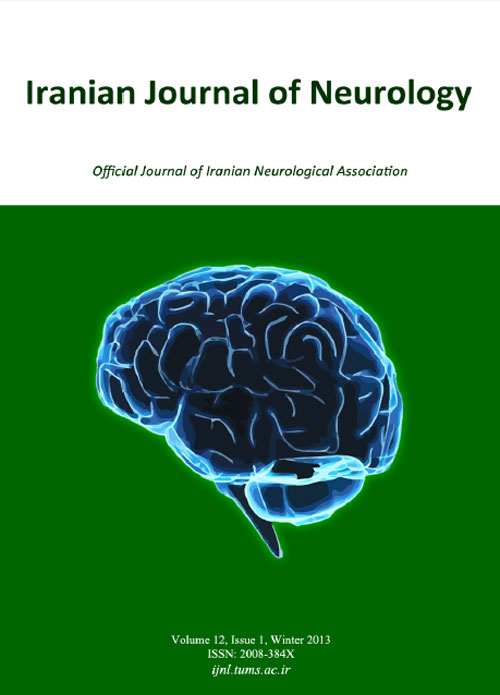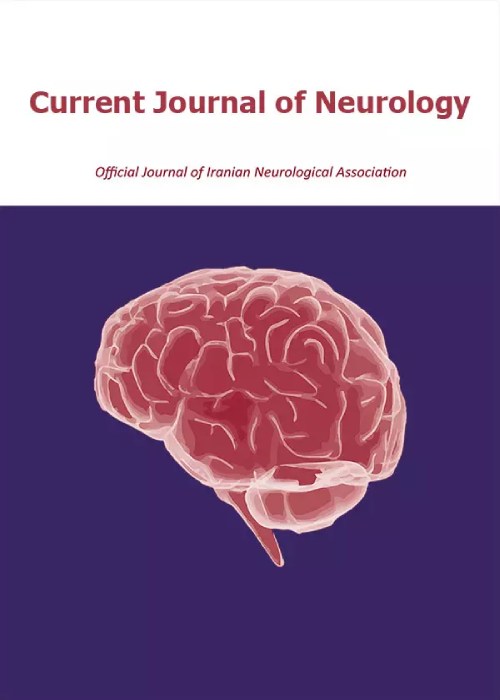فهرست مطالب

Current Journal of Neurology
Volume:12 Issue: 1, Winter 2013
- تاریخ انتشار: 1392/02/27
- تعداد عناوین: 11
-
-
Pages 1-8BackgroundThe clinical course of multiple sclerosis (MS) evolves over many years. Its prognosis is highly variable among affected individuals, i.e. while some suffer from early severe disabilities, others remain ambulatory and functional for many years. We used Multiple Sclerosis Severity Score (MSSS) and the new classification for MS severity Herbert et al. introduced in 2006 according to MSSS, to investigate some clinical and demographic factors as potential indicators of disease severity in in MS.MethodsDuring a six-month period, patients with definite MS according to the revised McDonald’s criteria who referred to three neurology and MS clinics in Tehran (Iran) were included in the study. All patients were interviewed and examined by a neurology resident who had been trained for employing the Expanded Disability Status Scale (EDSS). For each patient, MSSS was determined by using EDSS and disease duration.ResultsOverall, 338 (266 female and 72 male) patients were enrolled. Among demographic features, gender, younger age at onset, positive family history, and parental consanguinity were not associated with disease severity. Education was weakly associated with disease severity. Among clinical factors, presenting symptoms such as poly-symptomatic attacks, walking difficulty, and upper and lower extremity dysfunction were associated with more disability while presentation with optic neuritis had better prognosis. Complete recovery after the first attack, longer interval between the first and second attacks, lower number of symptoms at presentation, shorter duration of attacks, and relapsing-remitting course were associated with less disability and better prognosis. These results were noticed in ordinal logistic regression. However when multiple logistic regression was performed, the strongest determinant of disease severity was disease course with odds ratio (OR) = 49.12 for secondary progressive course and OR = 53.25 for primary progressive (± relapse) course. Walking difficulty as the presenting symptom had a borderline association with disease severity (OR = 2.31; P = 0.055). Increased number of onset symptoms was associated (but not significantly) with more severe disease.ConclusionEarly prediction of disease severity by demographic and clinical features is currently impossible. We need to determine stronger predictors, possibly a combination of demographic, clinical, biomarkers, and imaging findings.Keywords: Multiple Sclerosis, Severity, Demographic, Multiple Sclerosis Severity Score (MSSS)
-
Pages 9-14BackgroundWe compared bone mineral density (BMD) in patients with relapsing-remitting multiple sclerosis (RRMS) on interferon with that of patients with relapsing-remitting multiple sclerosis (RRMS) who were not receiving interferon and healthy age- and sex-matched controls.MethodsOverall, 30 patients with RRMS on interferon (treated patients), 30 patients with RRMS but not receiving interferon (untreated patients), and 30 healthy controls were enrolled. The subjects were matched for age, sex, body mass index, physical activity and nutritional habits (as possible), duration of illness, frequency of attacks, and the amount of corticosteroid therapy. BMD was measured at the lumbar spine and proximal femur. The results of dual-energy X-ray absorptiometry were expressed as BMD (g/cm2), Z-scores, and T-scores.ResultsOsteopenia in patients with RRMS was 61.7% in proximal femur and 53.3% in lumbar spine (vs. 53.3% and 40% in healthy controls, respectively). There was an inverse relationship between Expanded Disability Status Scale scores and lumbar and femoral BDM in the patients. In treated patients, there was an inverse relationship between the duration of interferon therapy and lumbar and femoral BDM. In untreated patients, there was a similar relation between the duration of the illness and BMD. Moreover, inverse relationships existed between the frequency of attacks and lumbar and femoral BDM in both treated and untreated groups. However, this association was only significant in the untreated group.ConclusionPatients with MS showed reduced BMD in comparison with healthy controls. This reduction was related to the frequency of attacks. We also found lower BMD in untreated patients compared to interferon-treated patients.Keywords: Relapsing, Remitting Multiple Sclerosis, Interferon, Bone Mineral Densitometry
-
Pages 15-18BackgroundGuillain-Barre syndrome (GBS) is an acute immune-mediated peripheral neuropathy usually after an incident. This study was performed to investigate the basic epidemiologic features of GBS in south of Iran.MethodsWe studied consecutive patients with GBS in Namazi Hospital of Shiraz, southern Iran. Demographic characteristics of the subjects, i.e. age, sex, and length of hospital stay were extracted. Information regarding yearly admissions for the entire hospital was also gathered. The prevalence of GBS per 10,000 hospital admissions was calculated and stratified by sex and year. Yearly prevalence was compared using the odds ratio (OR) and 95% confidence intervals (CI).ResultsFrom January 2000 to December 2009, 389 (232 males and 157 females) patients with GBS were admitted in our center. The mean age of patients was 29.8 ± 23.0 years and their mean length of hospital stay was 12.9 ± 11.6 days. The overall mortality rate was 6%. The ratio of admissions due to GBS to the total admissions was significantly higher in 2009, the year of an influenza A (H1N1) virus pandemic.ConclusionThere appears to be an increase in the incidence of GBS in Shiraz. This is in parallel with the increasing trend of some other autoimmune diseases.Keywords: Guillain_Barre Syndrome_Epidemiology_Influenza A Virus_H1N1 Subtype_Pandemics_Periodicity
-
Pages 19-22BackgroundMultiple sclerosis (MS) is a demyelinating disease which can cause many disabilities for the patient. Recent data suggests that MS patients have higher risk for osteoporosis. This study was performed to investigate if the osteoporosis prevalence is higher in MS patients and to determine the possible factors affecting bone mineral density (BMD).Methods51 definite relapsing-remitting MS patients according to McDonald's criteria (45 females, 6 males aged between 20 and 50 years) participated in this study. The control group included 407 females aged from 20 to 49 years; they were healthy and had no history of the diseases affecting bone metabolism. Femoral and lumbar BMD were measured by Dual Energy X-ray Absorptiometry (DXA). The disability of MS patients was evaluated by Expanded Disability Status Scale (EDSS). The patient’s quality of life was evaluated by the validated Persian version of multiple sclerosis impact scale (MSIS-29).ResultsPatients’ mean age was 36 ± 3.3 years and their mean disease duration was 8.7 ± 1.7 years. The mean EDSS score and the mean body mass index (BMI) of the patients were 3 ± 0.9 and 23.5 ± 2.3 kg/m2, respectively. 29% of the patients had never been treated by ß-interferon and 6% of them had not received glucocorticoids (GCs) pulses since their MS had been diagnosed. 26% of the patients had a history of fracture.18% of our patients were osteoporotic and 43% of them were osteopenic. Femoral BMD was significantly lower among MS patients than age matched controls (P < 0.001), but lumbar BMD showed no difference. There was no correlation between administration of GCs pulses, interferon and BMD; however, we found a significant correlation between EDSS score, quality of life (QoL), disease duration and BMD of both site.ConclusionAs a result of this study, bone loss inevitably occurs in MS patients. The major factor of BMD loss is immobility. Osteoporosis should be managed as part of MS patients’ treatment protocols.Keywords: Multiple Sclerosis, Bone Mineral Density, Osteoporosis, Quality of Life, Disability
-
Pages 23-27BackgroundObesity seems to be associated to migraine headache. Increase in body fat, especially in gluteofemoral region, elevates adiponectin and leptin secretion which in turn impair inflammatory processes that could be contributing to migraine risk. This study was designed to assess the relationship between body composition and risk of migraine for the first time.MethodsIn this cross-sectional study, 1510 middle-aged women who were visited in a weight reduction clinic of university were recruited. Migraine was diagnosed with HIS criteria. Body composition parameters including total fat mass (FATM), total fat free mass (FFM), truncal fat mass (TFATM), and truncal fat free mass (TFFM) was assessed using bioelectric impedance. We further assessed cardiovascular risk factors and smoking as confounding factors. To determine the real association between different variables and risk of migraine, the associations were adjusted by multivariate logistic regression analysis.ResultsElevation in fasting blood sugar, total cholesterol, LDL cholesterol, FFM, TFFM, and waist-to-hip ratio increased the risk of migraine. When the associations were adjusted for other factors, only the association between migraine and FFM remained statistically significant.ConclusionLower FFM increased the risk of migraine in overweight and obese individuals. In the other words, higher fat free mass could be a protective factor for migraine.Keywords: Migraine, Fat Free Mass, Truncal Fat Free Mass, Obesity
-
Pages 28-29Schwannomas are relatively rare but benign nerve sheath tumors deriving from Schwann cells with low tendency of transformation to malignancy. Extracranial shwannomas usually present insidiously and thus are often diagnosed incorrectly or after lengthy delays. We present the case of a 51 years old female patient with chronic cervical pain radiating in left upper limb who was treated as cervical radiculopathy for 5 years. By aggrevation of pain and paresthesia, imaging and electrodiagnostic study revealed schwannoma of brachial plexus. In case of radiating pain and paresthesia in upper limb (such as this case) symptoms can be misleading for cervical radiculopathy but careful examination especialy in persistence of symptoms with negative imaging results for radiculopathies are important and electrodiagnostic study can be helpful.Keywords: Brachial Plexus, Schwannoma, Radiculopathy
-
Pages 30-31
-
Pages 32-34BackgroundFatigue, a major cause of disability in individuals with multiple sclerosis (MS), is associated with reduced quality of life. The aim of this study was to evaluate the reliability and reproducibility of the Persian version of Modified Fatigue Impact Scale (MFIS) in Iranian patients with MS.MethodsThis study included 15 subjects with clinically definite MS, 15 hospitalized patients with MS, and 15 hospitalized patients with other chronic illnesses (as controls). They filled in the Persian version of the MFIS twice with a three-day interval. MFIS items were analyzed and the correlation coefficient was calculated.ResultsThere was a good correlation between the scores of the two measurements (correlation coefficient: 0.984, P < 0.001) especially in physical and cognitive subgroups. The reproducibility of psychosocial subscale was lower than physical and cognitive subscales.ConclusionAccording to our findings, the Persian version of the MFIS has a good reliability and reproducibility for assessment of fatigue in patients with MS.Keywords: Multiple Sclerosis, Fatigue, Persian Translation, Modified Fatigue Impact Scale


